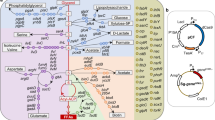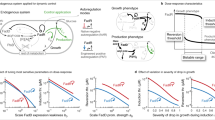Abstract
Metabolic engineering has achieved encouraging success in producing foreign metabolites in a variety of hosts. However, common strategies for engineering metabolic pathways focus on amplifying the desired enzymes and deregulating cellular controls. As a result, uncontrolled or deregulated metabolic pathways lead to metabolic imbalance and suboptimal productivity. Here we have demonstrated the second stage of metabolic engineering effort by designing and engineering a regulatory circuit to control gene expression in response to intracellular metabolic states. Specifically, we recruited and altered one of the global regulatory systems in Escherichia coli, the Ntr regulon, to control the engineered lycopene biosynthesis pathway. The artificially engineered regulon, stimulated by excess glycolytic flux through sensing of an intracellular metabolite, acetyl phosphate, controls the expression of two key enzymes in lycopene synthesis in response to flux dynamics. This intracellular control loop significantly enhanced lycopene production while reducing the negative impact caused by metabolic imbalance. Although we demonstrated this strategy for metabolite production, it can be extended into other fields where gene expression must be closely controlled by intracellular physiology, such as gene therapy.
This is a preview of subscription content, access via your institution
Access options
Subscribe to this journal
Receive 12 print issues and online access
$209.00 per year
only $17.42 per issue
Buy this article
- Purchase on Springer Link
- Instant access to full article PDF
Prices may be subject to local taxes which are calculated during checkout





Similar content being viewed by others

References
Bailey, J.E. Toward a science of metabolic engineering. Science 252, 1668–1675 (1991).
Guillouet, S., Rodal, A.A., An, G., Lessard, P.A. & Sinskey, A.J. Expression of the Escherichia coli catabolic threonine dehydratase in Corynebacterium glutamicum and its effect on isoleucine production. Appl. Environ. Microbiol. 65, 3100–3107 (1999).
Kurland, C.G. & Dong, H. Bacterial growth inhibition by overproduction of protein. Mol. Microbiol. 21, 1–4 (1996).
Sies, H. & Stahl, W. Lycopene: antioxidant and biological effects and its bioavailability in the human. Proc. Soc. Exp. Biol. Med. 218, 121–124 (1998).
Giovannucci, E. Tomatoes, tomato-based products, lycopene and cancer: review of the epidemiological literature. J. Natl. Cancer Inst. 91, 317–331 (1999).
Wang, C.-W., Oh, M.-K. & Liao, J.C. Engineered isoprenoid pathway enhances astaxanthin production in Escherichia coli. Biotechnol. Bioeng. 62, 235–241 (1999).
Miura, Y. et al. Production of the carotenoids lycopene, β-carotene, and astaxanthin in the food yeast Candida utilis. Appl. Environ. Microbiol. 64, 1226–1229 (1998).
Kajiwara, S., Fraser, P.D., Kondo, K. & Misawa, N. Expression of an exogenous isopentenyl diphosphate isomerase gene enhances isoprenoid biosynthesis in Escherichia coli. Biochem. J. 324, 421–426 (1997).
Ruther, A., Misawa, N. & Sandmann, G. Production of zeaxanthin in Escherichia coli transformed with different carotenogenic plasmids. Appl. Microbiol. Biotechnol. 48, 162–167 (1997).
Hoch, J.A. & Silhavy, T.J. Two-component signal transduction. (ASM Press, Washington, DC; 1995).
Nyström, T. The glucose-starvation stimulon of Escherichia coli: induced and repressed synthesis of enzymes of central metabolic pathways and role of acetyl phosphate in gene expression and starvation survival. Mol. Microbiol. 12, 833–843 (1994).
McCleary, W.R. & Stock, J.B. Acetyl phosphate and the activation of two-component response regulators. J. Biol. Chem. 269, 31567–31572 (1994).
Stock, J.B., Surette, M., McCleary, W.R. & Stock, A.M. Signal transduction in bacterial chemotaxis. J. Biol. Chem. 267, 19753–19756 (1992).
Kim, S.-K., Wilmes-Riesenberg, M.R. & Wanner, B.L. Involvement of the sensor kinase EnvZ in the in vivo activation of the response regulator PhoB by acetyl phosphate. Mol. Microbiol. 22, 135–147 (1996).
Feng, J. et al. Role of phosphorylated metabolic intermediates in the regulation of glutamine synthetase synthesis in Escherichia coli. J. Bacteriol. 174, 6061–6070 (1992).
Reitzer, L.J. & Magasanik, B. Expression of glnA in Escherichia coli is regulated at tandem promoters. Proc. Natl. Acad. Sci. USA 82, 1979–1983 (1985).
Liu, J. & Magasanik, B. Activation of the dephosphorylation of nitrogen regulator I-phosphate of Escherichia coli. J. Bacteriol. 177, 926–931 (1995).
Hwang, I., Thorgeirsson, T., Lee, J., Kustu, S. & Shin, Y.K. Physical evidence for a phosphorylation-dependent conformational change in the enhancer-binding protein NtrC. Proc. Natl. Acad. Sci. USA 96, 4880–4885 (1999).
Patnaik, R., Roof, W.D., Young, R.F. & Liao, J.C. Stimulation of glucose catabolism in Escherichia coli by a potential futile cycle. J. Bacteriol. 174, 7527–7532 (1992).
Sprenger, G.A. et al. Identification of a thiamin-dependent synthase in Escherichia coli required for the formation of the 1-deoxy-D-xylulose 5-phosphate precursor to isoprenoids, thiamin, and pyridoxol. Proc. Natl. Acad. Sci. USA 94, 12857–12862 (1997).
Misawa, N. et al. Elucidation of the Erwinia uredovora carotenoid biosynthetic pathway by functional analysis of gene products expressed in Escherichia coli. J. Bacteriol. 172, 6704–6712 (1990).
Lerner, C.G. & Inouye, M. Low copy number plasmids for regulated low-level expression of cloned genes in Escherichia coli with blue/white insert screening capability. Nucleic Acids Res. 18, 4631 (1990).
Fürste, J.P. et al. Molecular cloning of the plasmid RP4 primase region in a multi-host range tacP expression vector. Gene 48, 119–131 (1986).
Patnaik, R., Spitzer, R.G. & Liao, J.C. Pathway engineering for production of aromatics in Escherichia coli: confirmation of stoichiometric analysis by independent modulation of AroG, TktA, and Pps activities. Biotechnol. Bioeng. 46, 361–370 (1995).
Patnaik, R. & Liao, J.C. Engineering of Escherichia coli central metabolism for aromatic metabolite production with near theoretical yield. Appl. Environ. Microbiol. 60, 3903–3908 (1994).
Dedhia, N., Richins, R., Mesina, A. & Chen, W. Improvement in recombinant protein production in ppGpp-deficient Escherichia coli. Biotechnol. Bioeng. 53, 379– (1997).
Farmer, W.R. & Liao, J.C. Reduction of aerobic acetate production by Escherichia coli. Appl. Environ. Microbiol. 63, 3205–3210 (1997).
Möckel, B., Eggeling, L. & Sahm, H. Threonine dehydratases of Corynebacterium glutamicum with altered allosteric control: their generation and biochemical and structural analysis. Mol. Microbiol. 13, 833–842 (1993).
Fussenegger, M., Schlatter, S., Bailey, J.E. & Mazur, X. Controlled proliferation by multigene metabolic engineering enhances the productivity of Chinese hamster ovary cells. Nat. Biotechnol. 16, 468–472 (1998).
Stewart, V. & Parales, J., Jr. Identification and expression of genes narL and narX of the nar (nitrate reductase) locus in Escherichia coli K-12. J. Bacteriol. 170, 1589–1597 (1988).
Silhavy, T.J., Berman, M.L. & Enquist, L.W. Experiments with gene fusions. (Cold Spring Harbor Laboratory Press, Cold Spring Harbor, NY; 1984).
Simons, R.W., Houman, F. & Kleckner, N. Improved single and multicopy lac -based cloning vectors for protein and operon fusions. Gene 53, 85–96 (1987).
Draths, K.M. et al. Biocatalytic syntesis of aromatics from D-glucose: the role of transketolase. J. Am. Chem. Soc. 114, 3956–3962 (1992).
Laemmli, U.K. Cleavage of structural proteins during the assembly of the head of bacteriophage T4. Nature 227, 680–685 (1970).
Miller, J.H. A short course in bacterial genetics: a laboratory manual and handbook for Escherichia coli and related bacteria. (Cold Spring Harbor Laboratory Press, Cold Spring Harbor, NY; 1992).
Acknowledgements
The authors gratefully acknowledge Chia-wei Wang of our laboratory for the construction of pCW9. This work was supported by the National Science Foundation (grant BES-9814097) and the US Department of Energy (DE-FG03-95ER20205).
Author information
Authors and Affiliations
Corresponding author
Rights and permissions
About this article
Cite this article
Farmer, W., Liao, J. Improving lycopene production in Escherichia coli by engineering metabolic control. Nat Biotechnol 18, 533–537 (2000). https://doi.org/10.1038/75398
Received:
Accepted:
Issue Date:
DOI: https://doi.org/10.1038/75398
This article is cited by
-
Using a synthetic machinery to improve carbon yield with acetylphosphate as the core
Nature Communications (2023)
-
Toward improved terpenoids biosynthesis: strategies to enhance the capabilities of cell factories
Bioresources and Bioprocessing (2022)
-
Dynamic control of 4-hydroxyisoleucine biosynthesis by multi-biosensor in Corynebacterium glutamicum
Applied Microbiology and Biotechnology (2022)
-
Application of quorum sensing system in microbial synthesis of valuable chemicals: a mini-review
World Journal of Microbiology and Biotechnology (2022)
-
Fine tuning the glycolytic flux ratio of EP-bifido pathway for mevalonate production by enhancing glucose-6-phosphate dehydrogenase (Zwf) and CRISPRi suppressing 6-phosphofructose kinase (PfkA) in Escherichia coli
Microbial Cell Factories (2021)


